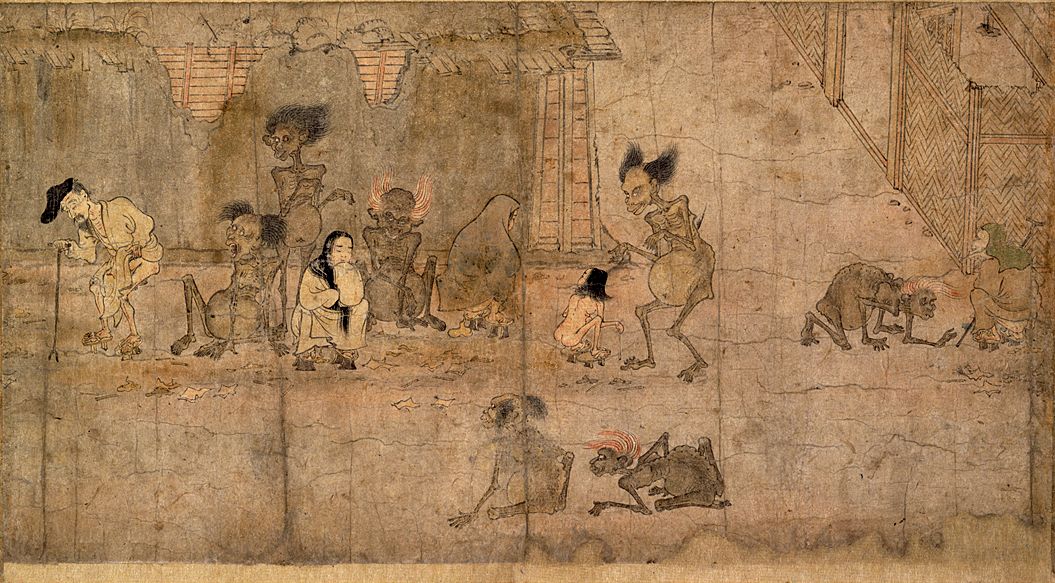|
Segaki
The is a ritual of Japanese Buddhism, traditionally performed to stop the suffering of the such restless ghosts/monsters as , and --the dead who have no living relatives)--all ghosts tormented by an insatiable hunger. Alternatively, the ritual forces them to return to their portion of hell or keeps the spirits of the dead from falling into the realm of the gaki. The segaki may be performed at any time, but traditionally performed as part of the yearly '' Urabon'e'' ( ''Ullambana'') services in July to remember the dead and the segaki ritual for offering alms to specifically hungry gaki or muenbotoke, not for spirits of one's ancestor. The ritual is held at Buddhist temples and there is a custom to place segaki-dana (rack for gaki) or gaki-dana (shelf for gaki) at home, present offerings (traditionally rice and water) for hungry ghosts who are wandering in this world as muenbotoke during Urabon'e or O-bon. The segaki began as a way for Moggallana (Maudgalyāna in Sanskrit), on ... [...More Info...] [...Related Items...] OR: [Wikipedia] [Google] [Baidu] |
Gaki-do
''Preta'' (, ''yi dags''), also known as hungry ghost, is the Sanskrit name for a type of supernatural being described in Hinduism, Buddhism, Taoism, and Chinese folk religion as undergoing suffering greater than that of humans, particularly an extreme level of hunger and thirst. They have their origins in Indian religions and have been adopted into East Asian religions via the spread of Buddhism. Preta is often translated into English as "hungry ghost" from the Chinese and East Asian adaptations. In early sources such as the ''Petavatthu'', they are much more varied. The descriptions below apply mainly in this narrower context. The development of the concept of the preta started with just thinking that it was the soul and ghost of a person once they died, but later the concept developed into a transient state between death and obtaining karmic reincarnation in accordance with the person's fate. In order to pass into the cycle of karmic reincarnation, the deceased's family must ... [...More Info...] [...Related Items...] OR: [Wikipedia] [Google] [Baidu] |
Maudgalyayana
Maudgalyāyana (), also known as Mahāmaudgalyāyana or by his birth name Kolita, was one of Gautama Buddha, the Buddha's closest disciples. Described as a contemporary of disciples such as Subhuti, Śāriputra ('), and Mahākāśyapa (), he is considered the second of the Buddha's two foremost male disciples, together with Śāriputra. Traditional accounts relate that Maudgalyāyana and Śāriputra become spiritual wanderers in their youth. After having searched for spiritual truth for a while, they come into contact with the Buddhist teaching through verses that have become widely known in the Buddhist world. Eventually they meet the Buddha himself and upasampada, ordain as monks under him. Maudgalyāyana attains Enlightenment in Buddhism, enlightenment shortly after that. Maudgalyayana and Śāriputra have a deep spiritual friendship. They are depicted in Buddhist art as the two disciples that accompany the Buddha, and they have complementing roles as teachers. As a teacher, ... [...More Info...] [...Related Items...] OR: [Wikipedia] [Google] [Baidu] |
Yujia Yankou
The ''Yujia Yankou'' rite (Traditional Chinese characters, Chinese: 瑜伽燄口; pinyin: ''Yújiā Yànkǒu''), also known as the ''Yuqie Yankou'' rite, translated as the "Yoga Flaming Mouth Food Bestowal Rite", is an esoteric Chinese Buddhism, Chinese Buddhist ritual performed with the aim of feeding all Sentient beings (Buddhism), sentient beings in Saṃsāra (Buddhism), saṃsāra. It is commonly performed during or at the end of regular religious temple events such as repentance rites (Traditional Chinese characters, Chinese: 懺悔; pinyin: ''Chànhǔi''), Buddha recitation retreats (Traditional Chinese characters, Chinese: 佛七; pinyin: ''Fóqī''), the dedication of a new monastic complex or gatherings for the transmission of monastic vows. It is also widely performed as a post-mortem rite within Chinese society during funerals and other related occasions such as the Ghost Festival. While the ritual originated as a rite to feed hungry ghosts, or ''egui'' (Traditional Chin ... [...More Info...] [...Related Items...] OR: [Wikipedia] [Google] [Baidu] |
Obon
or just is a fusion of the ancient Japanese belief in ancestral spirits and a Japanese Buddhist custom to honor the spirits of one's ancestors. This Buddhist custom has evolved into a family reunion holiday during which people return to ancestral family places and visit and clean their ancestors' graves when the spirits of ancestors are supposed to revisit the household altars. It has been celebrated in Japan for more than 500 years and traditionally includes a dance, known as . The festival of Obon lasts for three days; however, its starting date varies within different regions of Japan. When the lunar calendar was changed to the Gregorian calendar at the beginning of the Meiji era, the localities in Japan responded differently, which resulted in three different times of Obon. Traditionally, Obon was celebrated on the 15th day of the seventh month of the lunar calendar. Obon is now observed during one of the following periods: * July 15 of the Gregorian calendar (Shichig ... [...More Info...] [...Related Items...] OR: [Wikipedia] [Google] [Baidu] |
Exorcism
Exorcism () is the religious or spiritual practice of evicting demons, jinns, or other malevolent spiritual entities from a person, or an area, that is believed to be possessed. Depending on the spiritual beliefs of the exorcist, this may be done by causing the entity to swear an oath, performing an elaborate ritual, or simply by commanding it to depart in the name of a higher power. The practice is ancient and part of the belief system of many cultures and religions. Christianity In Christianity, exorcism is the practice of casting out or getting rid of demons. In Christian practice, the person performing the exorcism, known as an exorcist, is a member of a Christian Church, or an individual thought to be graced with special powers or skills. The exorcist may use prayers and religious material, such as set formulae, gestures, symbols, sacred images, sacramentals, etc. The exorcist often invokes God, Jesus or several different angels and archangels to intervene with the ... [...More Info...] [...Related Items...] OR: [Wikipedia] [Google] [Baidu] |
Dharma Name
A Dharma name is a new name acquired during both lay and monastic Buddhist initiation rituals in Mahayana Buddhism and Pabbajjā, monastic ordination in Theravada Buddhism (where it is more proper to call it Dhamma or Sangha name). The name is traditionally given by a Buddhist monasticism, Buddhist monastic, and is given to newly ordained Bhikkhu, monks, Bhikkhunī, nuns and laity. Dharma names are considered aspirational, not descriptive. Most of the well-known Buddhist teachers are known to have had many different Dharma names in the course of their careers, and often each name represents a stage of their career. For example, Prince Shotoku was also known as Prince Umayado and Prince Kamitsumiya. Shinran's original name was Matsuwakamaru; he was also known as Hanen, Shakku, Zenshin, Gutoku Shinran and Kenshin Daeshi. Nichiren's original name was Zennichi and his Dharma names were Zenshobo Rencho and Rissho Daishi. Similarly, the tradition of various Dharma names was also used ... [...More Info...] [...Related Items...] OR: [Wikipedia] [Google] [Baidu] |
Routledge
Routledge ( ) is a British multinational corporation, multinational publisher. It was founded in 1836 by George Routledge, and specialises in providing academic books, academic journals, journals and online resources in the fields of the humanities, behavioral science, behavioural science, education, law, and social science. The company publishes approximately 1,800 journals and 5,000 new books each year and their backlist encompasses over 140,000 titles. Routledge is claimed to be the largest global academic publisher within humanities and social sciences. In 1998, Routledge became a subdivision and Imprint (trade name), imprint of its former rival, Taylor & Francis, Taylor & Francis Group (T&F), as a result of a £90-million acquisition deal from Cinven, a venture capital group which had purchased it two years previously for £25 million. Following the merger of Informa and T&F in 2004, Routledge became a publishing unit and major imprint within the Informa "academic publishing ... [...More Info...] [...Related Items...] OR: [Wikipedia] [Google] [Baidu] |
Sri Lanka
Sri Lanka, officially the Democratic Socialist Republic of Sri Lanka, also known historically as Ceylon, is an island country in South Asia. It lies in the Indian Ocean, southwest of the Bay of Bengal, separated from the Indian subcontinent, Indian peninsula by the Gulf of Mannar and the Palk Strait. It shares a maritime border with the Maldives in the southwest and India in the northwest. Sri Jayawardenepura Kotte is the legislative capital of Sri Lanka, while the largest city, Colombo, is the administrative and judicial capital which is the nation's political, financial and cultural centre. Kandy is the second-largest urban area and also the capital of the last native kingdom of Sri Lanka. The most spoken language Sinhala language, Sinhala, is spoken by the majority of the population (approximately 17 million). Tamil language, Tamil is also spoken by approximately five million people, making it the second most-spoken language in Sri Lanka. Sri Lanka has a population of appr ... [...More Info...] [...Related Items...] OR: [Wikipedia] [Google] [Baidu] |
China
China, officially the People's Republic of China (PRC), is a country in East Asia. With population of China, a population exceeding 1.4 billion, it is the list of countries by population (United Nations), second-most populous country after India, representing 17.4% of the world population. China spans the equivalent of five time zones and Borders of China, borders fourteen countries by land across an area of nearly , making it the list of countries and dependencies by area, third-largest country by land area. The country is divided into 33 Province-level divisions of China, province-level divisions: 22 provinces of China, provinces, 5 autonomous regions of China, autonomous regions, 4 direct-administered municipalities of China, municipalities, and 2 semi-autonomous special administrative regions. Beijing is the country's capital, while Shanghai is List of cities in China by population, its most populous city by urban area and largest financial center. Considered one of six ... [...More Info...] [...Related Items...] OR: [Wikipedia] [Google] [Baidu] |







